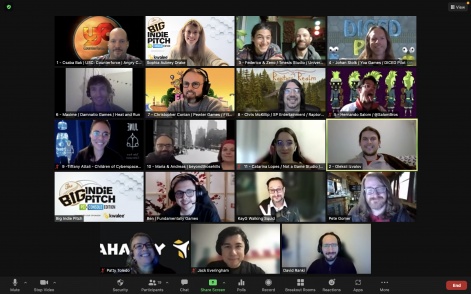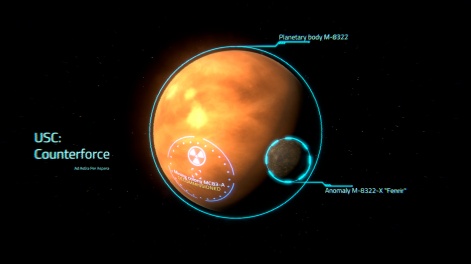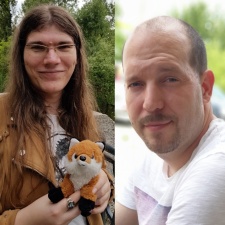The Big Indie Pitch is a regular event run by the makers of Pocket Gamer and PC Games Insider. It sees indie developers engage in a speed-dating-styled pitching competition for fame and those sweet, sweet promotional packages.
The event gives indies five minutes to pitch their games to a panel of press, publishers and industry pundits. The judges then pick three winners and everybody gets valuable feedback.
The indie view
The Big Indie Pitch is getting bigger and bigger as we bring it to events all across the world. To give you an idea of what the event is like, who attends the events and the games on show, we've sat down with a number of past PC Indie Pitch contestants to offer their views.
Today, we're speaking to Csaba Bak & Aliza Wenders, who submitted USC: Counterforce to The Big Indie Pitch (PC+Console Edition) at Pocket Gamer Connects Digital NEXT sponsored by our season sponsors Kwalee, and walked away as the runner-up.

Sophia Aubrey Drake: Tell us a little about yourself and your indie studio - who is on the team, and what are their inspirations?
Aliza Wenders: We are indeed a very small team. There’s me, Aliza Wenders, and I am the lead developer/game designer and the only programmer, and there is Csaba Bak, who’s my “apprentice”, a junior game designer who helps me with ideas, testing, PR, and marketing. That’s all, folks.
As for inspirations, I started programming on the Commodore 64, and ever since I’m on the quest of creating games, and not only for the computer. I designed tabletop RPGs too. I enjoy developing complex environments and rules in which a “controlled chaos” can unfold, like in USC. Csaba is in love with the process of making a game and wants to learn how to create that exquisite feeling he experienced playing video games in his childhood.
Tell us about USC: Counterforce that you pitched at the competition.
Aliza Wenders: It is the sequel to Ultimate Space Commando, our first game that we released in 2015. It’s a turn-based strategy/tactics game with a heavy focus on squad-level micro-management and very tense close-combat scenarios. Mechanically it’s heavily inspired by good old classics like Laser Squad, Incubation, the old UFO (X-Com), and Space Crusade, but if you take a closer look at the rules behind the game, you’ll find that it’s also very different from all of those. There’s an original, over-arching story to the two games, and USC: CF continues that from the first game.

What do you think are the most unique and interesting aspects of USC: Counterforce that gamers may never have seen before.
Aliza Wenders: First of all, the story. I love both modern sci-fi thriller/horror/monster flicks and classic science fiction literature, and I know it’s very hard to create something truly unique, but I feel the USC games’ story is special. You don’t really see it in the first game (except for some lore elements), because it’s like the prologue of a greater story that will unfold now. The alien threat you face is not at all what you think it is. But it’s up to the player to piece together the elements before it’s too late.
The game will not hold your hand, and the semi-randomized campaign will have many different endings based on your actions. There won’t be a fully complete narrative you can’t change. You’ll be able to make decisions that completely change how you progress with your campaign. For example, you’ll have the option to utilize the orbiting USCF fleet and launch tactical nukes on the planet surface to eliminate threats, but this will change how certain missions are available to you, and how the aliens perceive you.
The alien “Horde” is also not your typical “evil spacefaring alien” race. They don’t have spaceships, they act more like “animals”, but of course, there’s the mystery of the Shadow Envoys who tried to communicate with you in the first game. You know nothing about them. All of this will come into play now. Also, you’re not defending Earth per se. You’re dispatched to “clean up” after the incident on the planet M-8322 (that took place in the first game), but are met with a very troubling situation. I don’t want to spoil things, though.
USC: Counterforce is a turn-based squad-focused RPG title. What made you choose this genre, and what do you think you bring to it that may not have been seen before?
Aliza Wenders: As I’ve said before, I like complex rule systems, and USC: CF definitely has one. It doesn’t mean it’s very hard to understand or play, it just means that combat has many layers you can master to become even better. There are elemental damage types, combos, knockback, armour penetration, frontal/rear armour, ranged and melee combat, you can move objects to make barricades, basically, the whole map is destructible, and the aliens will do come through the walls for you, and a lot of other small things like hazardous materials, reactor meltdowns, etc., you must pay attention to. Your marines are not defined by a class system; they have 9 skills and two specializations, and it’s up to you how you train them. Don’t forget, every single one of them is a marine. There’s no such thing they can’t fire this or that weapon just because they are not specialized in it, you specialize to handle things better, and not to be able to handle them at all.
The game is presented in a top-down view. The environment and the units are fully 3D, but it’s a very deliberate decision to make the gameplay “2D” (there’s still jumping and crouching), as it makes for a more dynamic and USC-like experience. Still, you’ll be able to see what your marines see through their personal head cameras, like in the movies. And just like in the first game, chaos will swiftly take place after you arrive at a mission. Things burn, explode, come crashing down, the aliens try to swarm you, and while you’re packing some really heavy firepower and can take them easily one-on-one, you’ll still feel you’re the hunted.
The game also uses the “old-school” Action Points system, where you can freely act with your units until you pass the turn, and are not limited to only a few actions and attacks per turn. In the 90s’, it was the default. In 2021, it’s kinda unique. This system also mitigates things like missing a 95% hit chance shot and dying to it. You can simply attack more, and have the chance to retreat if your attack fails (if you play well, that is).
How did you come to choose the platforms that you would develop USC: Counterforce for?
Aliza Wenders: Games like this are traditionally made for the PC, as the gameplay and the UI are very complex and need both a mouse and a keyboard to be played effectively. First and foremost we’re developing it for PC, on PC. A Linux and/or Mac port is possible, but for a two-person studio, it feels too big a task to bring USC: CF to the consoles. Not that we haven’t done it before, we released our puzzle-platformer Mimic Hunter on the Nintendo Switch, too.
Looking at the studio a little more now. How hard is it to survive as an Indie developer?
Aliza Wenders: I’ll let Csaba answer this question. But in short, it’s very very hard.
Csaba Bak: That’s the million-dollar question for each and every indie developer. We have learned that we should focus on projects that are much more planned, and which get more interactions from players in their early stage. For us, as a two-person studio, doing all the workflows that are usually done by tens or hundreds of workers in a bigger studio, is our greatest enemy. The time. We don’t have time to waste. Some of our decisions are more like predictions, for now. We still need to learn a lot. After attending events like this, new ways open up before us by getting in touch with other game devs, publishers, investors, and other participants of this market.
Are there any tips and advice you would give to independent developers out there who are just starting out?
Csaba Bak: Dream big, but choose your project carefully. Every little step will let you closer to success. Attend events, like ‘The Big Indie Pitch’, because they are a perfect place to pitch and showcase your game. Also, there are good speakers, and you will be able to learn a lot. You can get a lot of information about the services of this market, and also, you are able to talk with publishers and investors.
Aliza Wenders: Making a game is very difficult. It’s not only about the idea, the programming, the design, or the marketing stuff. You have to see it through from start to finish. You’ll lose strength along the way, burn out, and you must face these and all kinds of other problems. Remember the passion you had for your game when you started making it. A game is like a comedy movie, the hardest to make. Why? Because in this case, the “user” is a “player”. They need to be able to enjoy the game. It needs to have content, fun gameplay elements, atmosphere, immersion. Tech demos are not games.

How did you find your experience pitching as a part of the Big Indie Pitch?
Csaba Bak: It wasn’t the first time, however, the feeling was the same. I was very excited. As a preparation, we decided what and how to present to the jury. The main element was the gameplay itself. Right after the greeting, I have shared my screen to show the gameplay. As the game is in the alpha stage, I could show the random map generator, some combat situations, and the core mechanics themselves. Of course, we could’ve shown more things if we have had more time, but the 5-minutes mark forced us to cut all the unnecessary things and to focus on the essence of the game. We are very thankful to the organizers, to the judges, and to the sponsors as well for the opportunity to introduce ourselves.
What do you feel you have gained from the experience, and what do you still hope to gain?
Csaba Bak: After a few pitches, one becomes more proficient, and because the judges are very different, I learned to answer their questions and get back on track more easily than before. I had to expand my comfort zone because pitching in English before a jury, who are representatives of this industry is more than exciting. The situation itself forced me to concentrate on the task at hand, thus making me better at pitching, I’d like to think. Every such opportunity helps me to get better at communication.
What are your hopes for this game in the future, and do you have any plans for any future projects?
Aliza Wenders: There are already a lot of things we chose to leave out because it’s too much right now. If the game is successful, I’d really like to add some of these features back: a game mode where you can play as the aliens, online co-op/PvP (hot seat co-op is already part of the game), a sophisticated mission/level editor that any player can easily use, and maybe modding support. As for future projects, we already made some advanced prototypes that are on hold because of USC:CF, and have other ideas, too, but a third installation in the USC universe would also be very nice. Maybe in another genre? Or maybe I’ll stick to what I do best, turn-based strategy.
Want to show off your exciting new game? We host Big Indie Pitch events throughout the year, so be sure to keep an eye out on our events page for an event near you, or even our new Digital pitches.
All our upcoming pitches including how to enter can be found over on our upcoming events page on BigIndiePitch.com.
Get the latest news, interviews and in-depth analysis on Twitter, Facebook, and our daily newsletter.












